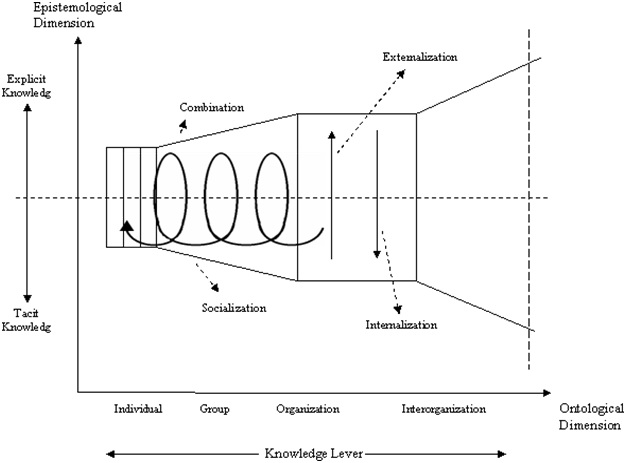
Insufficient consideration of the completeness of knowledge management models has been exposed, and I attempt to address this concern for the first time. This article investigates the crossover potential of scholarly research and how it can be applied in the corporate boardroom. Executives need to at least look at two models associated with knowledge management, which are directed at developing a better understanding of the concept of knowledge management within organizations.
1. Knowledge Creation Model
Why would executives care whether knowledge is implicit or explicit? The simple answer is that tacit knowledge is not shared and is sometimes bottled up in individuals causing a bottleneck in the organization. How can executives manage knowledge to enhance productivity if knowledge can be categorized as tacit and explicit knowledge? Since tacit knowledge is the knowledge that exists in the minds of organizational members, which is gained by their individual experiences, and is difficult to formalize and transfer unless directed to do so, executives need to pinpoint and encourage this type of knowledge to be drawn out of followers. More controllable, explicit knowledge is the knowledge that is highly formalized and codified, can be quickly recorded and communicated through formal and systematic language, and manifested in rules and procedures, providing the necessary tools and processes for executives to manage.
Two prominent scholars at Harvard Business School by the names of Hirotaka Takeuchi and Ikujiro Nonaka argue that tacit and explicit knowledge interacts through four processes, including socialization (i.e., tacit to implicit), externalization (i.e., tacit to clear), combination (i.e., explicit to explicit), and internalization (i.e., explicit to tacit). Executives can use socialization associated with coaching and mentoring activities by sharing experiences gained by imitating, observing, and practicing. In the externalization process, tacit knowledge is articulated into formal language representing official statements and equivalent to explicit knowledge. Executives have their internet technology departments create a combination that reshapes existing clear understanding to more systematic and complex forms by, for example, using internal databases. Most importantly, explicit knowledge is internalized through “learning by doing,” which is more engaging.
Figure 1 illustrates how knowledge can be converted to create new abilities that executives can view and implement immediately in managerial decision-making.
Figure 1: Knowledge Creation Model

While executives can use this model for knowledge management, they must also be aware of some criticisms. For example, there might be differences in managing personal knowledge from working knowledge at the organizational level, and they observe that this model has also ignored this matter. Barring the criticisms, this model can immediately be applied to large organizations, and executives can have someone on their team implement it accordingly.
2. Knowledge Cycle Model
Another easy model for executives to use is the knowledge cycle model. This model includes knowledge creation and construction, knowledge articulation, knowledge repository updating, knowledge access, knowledge use, and knowledge revision. Learning in organizations is the outcome of the knowledge cycle by which implicit knowledge is created and acquired by connecting knowledge with other companies that want to share successes and failures. This leads to converting acquired knowledge into organizational processes and activities to improve or discontinue strategies that either contribute to or inhibit success.
Executives can help followers add meaningfulness to their work by utilizing participation to enhance engagement. Then, tacit knowledge is incorporated into formal language and becomes available to share within organizations. Moreover, organizing explicit knowledge using databases and archives can make knowledge available throughout the organization—–organized knowledge can be disseminated and searched by others.
Also, training is an effective way to share explicit knowledge. Most importantly, applying knowledge to provide better decision-making and work-related practices and create new knowledge through innovation. Learning has to be measured in some way. Many trainers talk about return-on-investment of training which is hard to measure. Training satisfaction measurement by participants and their desire to apply it to the workplace is an excellent barometer of learning new skills or building upon old ones. Once knowledge is accumulated, the current processes may be supplemented or even substituted.
Figure 2 depicts this model. The critical point in the model is the knowledge use section coupled with testing and re-testing to ensure that the knowledge is helping the organization grow both professionally for individuals and profitably for all stakeholders.
Figure 2: Knowledge Cycle Model

Executives must be aware of some of the limitations of this model. For example, this model does not visualize the potential interactions between tacit and explicit knowledge and fails to account for the critical role of dynamic interrelationships among followers and business units in enhancing learning processes within large organizations. This model is also challenged in that the methods of use, measurement, and revision for tacit knowledge, if not impossible, are very hard. While the model’s limitations may only be at the surface level, executives may miss opportunities to entirely develop knowledge management systems based on these weaknesses.
In Conclusion
This article may be the answer executives need to have an all-encompassing understanding of knowledge management models to more effectively manage organizational knowledge. These models develop an integrated approach by which organizational learning contributes significantly to commercial objectives through the context-dependent way it is collected.
References
Nonaka, I., & Takeuchi, H. (1995). The knowledge-creating company: how Japanese companies create the dynamics of innovation, New York: Oxford University Press.




